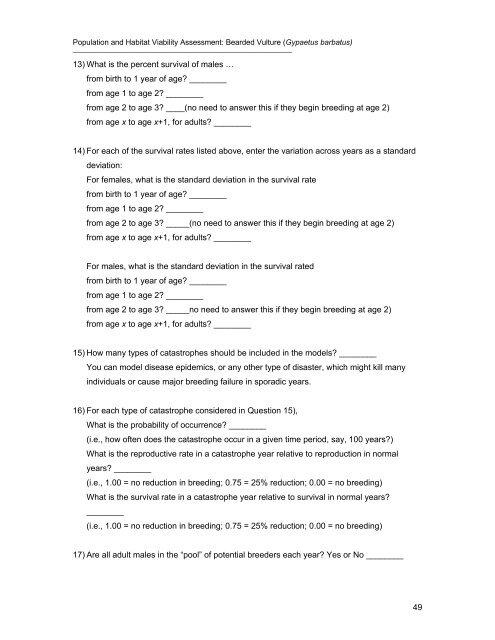BEARDED VULTURE POPULATION AND HABITAT VIABILITY ...
BEARDED VULTURE POPULATION AND HABITAT VIABILITY ...
BEARDED VULTURE POPULATION AND HABITAT VIABILITY ...
Create successful ePaper yourself
Turn your PDF publications into a flip-book with our unique Google optimized e-Paper software.
Population and Habitat Viability Assessment: Bearded Vulture (Gypaetus barbatus)<br />
________________________________________________<br />
13) What is the percent survival of males …<br />
from birth to 1 year of age? ________<br />
from age 1 to age 2? ________<br />
from age 2 to age 3? ____(no need to answer this if they begin breeding at age 2)<br />
from age x to age x+1, for adults? ________<br />
14) For each of the survival rates listed above, enter the variation across years as a standard<br />
deviation:<br />
For females, what is the standard deviation in the survival rate<br />
from birth to 1 year of age? ________<br />
from age 1 to age 2? ________<br />
from age 2 to age 3? _____(no need to answer this if they begin breeding at age 2)<br />
from age x to age x+1, for adults? ________<br />
For males, what is the standard deviation in the survival rated<br />
from birth to 1 year of age? ________<br />
from age 1 to age 2? ________<br />
from age 2 to age 3? _____no need to answer this if they begin breeding at age 2)<br />
from age x to age x+1, for adults? ________<br />
15) How many types of catastrophes should be included in the models? ________<br />
You can model disease epidemics, or any other type of disaster, which might kill many<br />
individuals or cause major breeding failure in sporadic years.<br />
16) For each type of catastrophe considered in Question 15),<br />
What is the probability of occurrence? ________<br />
(i.e., how often does the catastrophe occur in a given time period, say, 100 years?)<br />
What is the reproductive rate in a catastrophe year relative to reproduction in normal<br />
years? ________<br />
(i.e., 1.00 = no reduction in breeding; 0.75 = 25% reduction; 0.00 = no breeding)<br />
What is the survival rate in a catastrophe year relative to survival in normal years?<br />
________<br />
(i.e., 1.00 = no reduction in breeding; 0.75 = 25% reduction; 0.00 = no breeding)<br />
17) Are all adult males in the “pool” of potential breeders each year? Yes or No ________<br />
49


